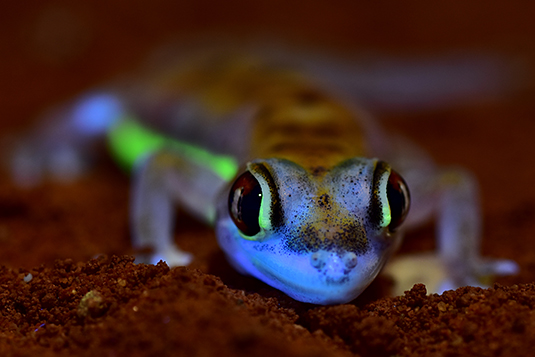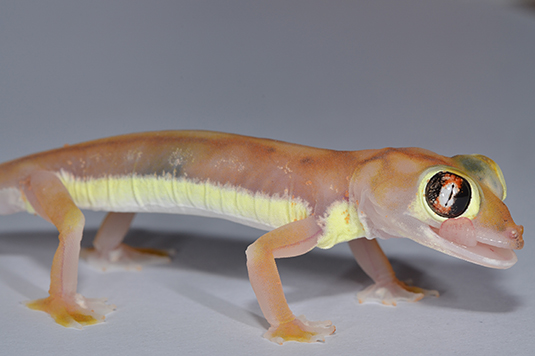Researchers at the LMU, the Bavarian State Collection of Zoology and Hochschule München have discovered a new mechanism for fluorescence in a terrestrial vertebrate

The web-footed gecko (Pachydactylus rangei) from the Namib desert fluoresces neon-green along its flank and around the eye under strong UV-light. This signal is best recognisable from the gecko's point of view. Photograph: David Prötzel (ZSM/LMU).
Biofluorescence is known from many aquatic organisms, but has recently been increasingly discovered in terrestrial vertebrates as well. So far, two fluorescence mechanisms have been described from reptiles and amphibians: bone-based fluorescence (all bone is naturally fluorescent under UV light), and fluorescence of a chemical in secreted and circulated in lymph fluid. Researchers at the Bavarian State Collection of Zoology, the Ludwig-Maximilians University and Hochschule München have now discovered a new mechanism for fluorescence in a terrestrial vertebrate. "As soon as we saw this fluorescence, we realised that the web-footed geckos must use a new mechanism: the bright, neon-green fluorescence patterns were clearly produced in the skin of the lizards", explains David Prötzel, first author of the study.

Foto: David Prötzel (ZSM/LMU)
Histological study of the web-footed gecko Pachydactylus rangei revealed, that the fluorescent areas of the skin are full of special pigment cells, the iridophores, which are absent in the non-fluorescent areas of the skin. Iridophores reflect light, and play an important role in the colouration of geckos and other lizards. For the first time, this study revealed that some iridophores can also fluoresce. "This effect is much stronger than the bone-based fluorescence that we discovered in chameleons three years ago and one of the brightest known cases of fluorescence ever found in terrestrial vertebrates," says Frank Glaw, curator of Reptiles and Amphibians at the Bavarian State Collection of Zoology.
The moon is the only source of light during the nightly forages of these geckos in the deserts of Namibia. The blue component of the moonlight is absorbed by the geckos' skin and emitted again as a brighter-looking, neon-green light. As though someone has taken a highlighter to these flanks, these geckos have a brightly visible signalling stripe.
Why so many animals fluoresce under blue or UV light is largely unclear. "In many vertebrates, it seems that fluorescence is purely coincidental. In the case of the web-footed gecko, however, the brightness of the fluorescence, and its placement on the body, strongly suggests that the fluorescence is a signal visible to other geckos, perhaps even over substantial distances in the open desert," explains Dr Mark Scherz, evolutionary biologist at the University of Potsdam.






